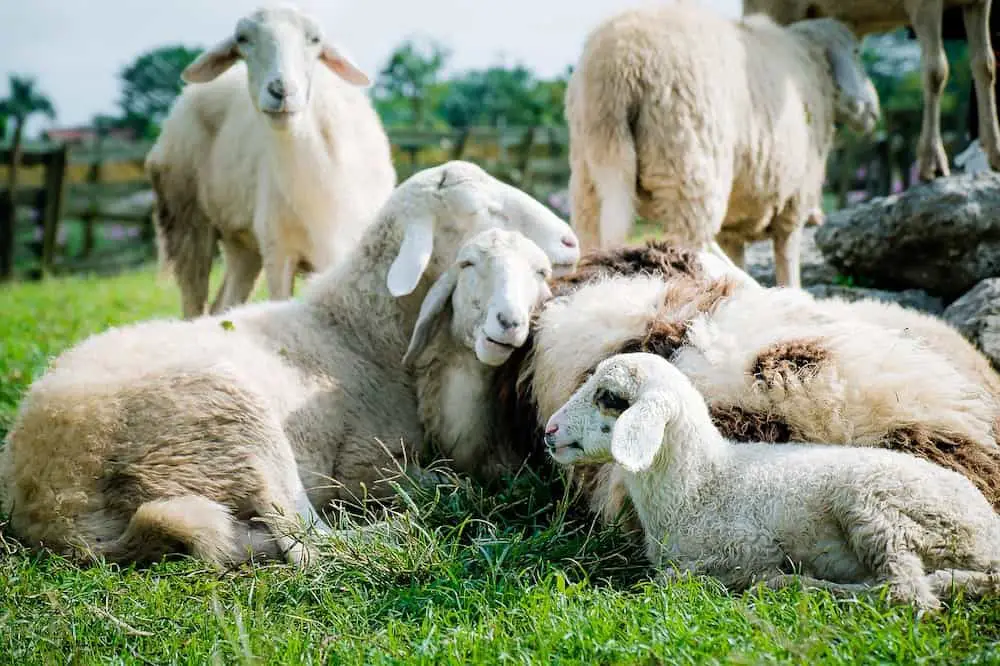Although Sheepskin rugs can add a unique charm to your otherwise cold, hard-wood floor – they are made with the skin and fleece of a once-living sheep.
Which begs the overarching question of whether it is cruel to have such an object and support this industry.
Sheepskin rugs are not necessarily cruel, but they can be unethical based on how the sheep was treated before it was slaughtered. Although a sheep died for human gain, no part of the animal goes to waste when it is used for these rugs, which is often not the case when they are killed for their meat.
Read on to learn more about how these rugs are made and the dominant arguments supporting or rejecting their ethical standing. In the end, you can make an informed decision about whether this is a piece of décor you want in your home.
Is the Process of Acquiring Sheepskin Cruel?
Just like the name suggests, sheepskin rugs are made from sheepskin. Unfortunately, there is no other way to acquire this material without killing the sheep itself. Usually, it's collected after the animal is slaughtered for its meat.
Unfortunately, only about 1 in 200 sheepskins are tanned (0.045%) and made into rugs. The rest are discarded as waste after the meat is collected. Unless the skins are tanned, they are essentially worthless.
The immediate process of acquiring sheepskin isn’t cruel because the animal is deceased for this process. Unless an individual or company is utterly devoid of humanity and skins the sheep alive, this is not a cruel product.
If you’re feeling uncomfortable about using sheep-based products, we understand. But it’s unnecessary to clump sheep byproducts like wool or even lanolin in the same category as sheepskins because no animals need to die in the process.
Instead, certain wool farmers do treat their sheep humanely and ethically – it’s just about knowing which sources to trust. You can read all about ethical wool here: Can Wool Be Cruelty-Free
And if you’re not sure about sheep shearing in general, we promise you that this read will help put your mind at ease: Is Sheep Shearing Cruel?
How Can Sheepskin Rugs Be Cruel?
The most powerful argument one could make for sheepskin rugs being cruel is if the sheep intended for slaughter are treated cruelly during their life and slaughtered callously.
Although many herders in the industry responsible for sheep husbandry would find this appalling and utterly disrespectful, that is not to say that it never happens.
Sadly, there are examples of companies that push for profit over proper animal care, and so, many sheep are treated cruelly before being slaughtered for mutton or shaved for their fleece.
There are occasions where sheep are physically punched, kicked, or thrown to subdue them even though these are incredibly docile animals. Additionally, many sheep that are shorn but not killed will be shorn roughly and cut from hasty razor work.
Of course, this does not occur in all locations that raise, slaughter, and shear sheep, but it is enough to give pause to supporting the industry. Consumers should research the source of their sheep products to avoid supporting companies that use cruel practices.
Are Sheepskin Rugs Ethical?
We’ve established that, as long as the sheep are cared for properly before slaughter and slaughtered humanely, acquiring their skin to make rugs is not cruel.
However, that does not necessarily mean it is not ethical. Here are the points most often made by each side of this argument regarding the ethics of sheepskin rugs.
Ethical Sheepskin Rugs
Many will favour sheepskin rugs since its an indication that the entire sheep was used after slaughter – nothing goes to waste.
These rugs are just a byproduct and rarely the cause of the animal’s slaughter. So, it’s difficult to argue that a sheep was killed needlessly for a rug since it would have already been slaughtered for a separate purpose.
Unfortunately, since these sheep are primarily slaughtered for meat, many companies discard the skin and fleece. Those who keep it either have a side business selling sheepskin products or partner with another company that will use it.
Because so few companies use sheepskin, most of it goes to waste. Many people support the manufacturing of these rugs because it helps ensure that if you are going to kill an animal, you use as much of it as possible. Making the death arguably more justified than wasteful.
Many companies strive to reduce this waste as well as creating sheepskin rugs most humanely and ethically as possible. This means that they only make rugs that are a byproduct of the meat industry. Some will even go as far as obtaining ethical certificates for their products.
In the end, the sheep is deceased when it is skinned for its fur to create sheepskin rugs. If the company has been certified as humane and ethical, then you have the peace of mind that your product is from a reliable source and limits the animal waste in the industry.
Unethical Sheepskin Rugs
Of course, the other side of the argument is that sheepskin rugs are unethical. If you’re one of the people that believe this to be true – it’s typically for one or more of these reasons:
Undoubtedly there is no justification for the cruel treatment of an animal regardless of your intentions for them.
We’ve briefly touched upon this point that far too many sheep are subjected to horrific conditions and treatment, all for human convenience.
Some people deem it unethical to support sheepskin rugs because it indirectly supports the industry – regardless of how the sheep were treated from the specific place you acquired the rug.
As long as there is room for profit in the market, someone will cut corners at the animal’s expense.
Another reason some people see these rugs as unethical is that they are subject to the tanning process for longevity, which can significantly damage the environment.
If you feel like delving deeper into this issue, then you can watch the prize-winning short documentary “The Toxic Price of Leather,” where Sean Gallagher’s Pulitzer exposes the horrific effects of the tanning industry on human health and the environment.
Globally, nearly 80% of leather is tanned using chrome and causes significant amounts of toxic waste to be released into waterways. All of this causes severe, life-threatening diseases for locals and animals that use this as their drinking water source.
Tannery workers also suffer from different diseases due to consistent close contact with the harsh chemicals necessary for this process.
And it doesn’t stop at just sheepskin – any leather can be highly damaging to the environment. So, if you’re about to buy a new pair of leather boots – we definitely suggest reading this article first: Can Leather Be Cruelty-Free?
Unfortunately, this proves that just because a product comes from a natural or organic source doesn’t mean it is good for the environment. By purchasing sheepskin rugs, you indirectly support the tanneries that create them and the environmental damage they cause.
In addition to the arguments regarding animal cruelty and environmental damage, many individuals find sheepskin rugs unethical because they are ultimately unnecessary. The general idea behind the product is to use a deceased animal’s skin and fur for decoration.
This has been a common argument for many similar products such as taxidermy and framed butterflies or other insects. Although you could certainly argue that displaying an animal’s corpse is distasteful and unethical, it is a highly subjective point with very little middle ground.
Final Thoughts
As a product, sheepskin rugs are not cruel unless the sheep have been treated poorly in their lives and the way they are slaughtered.
There are solid arguments for and against how ethical it is to have own one of these rugs and support the industries that create them.
What you conclude is entirely subjective and will vary depending on your personal values and moral compass.
Ultimately, if you are going to buy a sheepskin rug, make sure it does not come from a company that is cruel to their animals or mass produces the rugs.
If you find these products cruel or unethical, there are animal-friendly alternatives such as faux-sheepskin rugs you can purchase instead.


